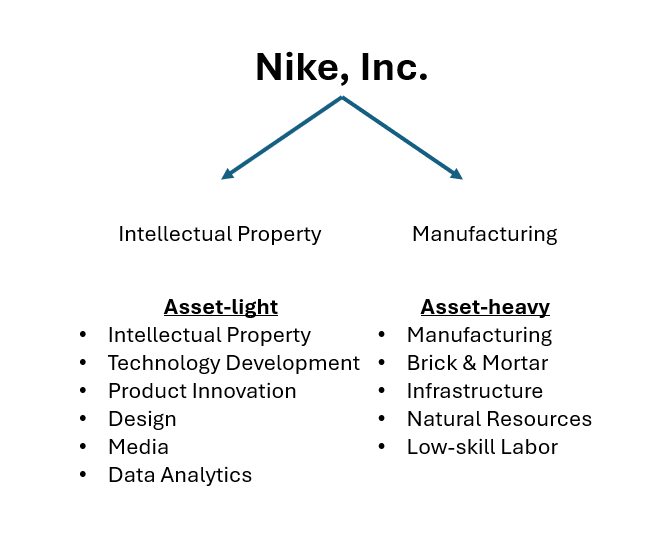Why do asset-light, IP business trade so high?
In recent years, the separation of asset-heavy from IP business units has increased.
This phenomenon is known as Nikefication.
Nikefication was pioneered by, hint, Nike.
This operational strategy separates design from production and distribution.
Corporations adopt a decentralized approach by outsourcing various functions like production and distribution to contractors.
By separating the different aspects of the business, companies can benefit from greater flexibility and efficiency in the form of higher operating margins and cash flow conversion.
Fundamentally, these businesses want to maintain the higher leverage activities – things that are highly valuable.
These activities tend to align with creating the necessary design and intellectual property as opposed to the manufacturing.

If we think about the fundamentals of manufacturing, it is less specialized and lower skill work.
The more commoditized an activity is, the fewer barriers to entry exist.
If anyone can get into your business, then the supply can overburden demand.
This fundamentally drives down price.
This leads to a pricing war where only the most lean companies with often large scale can survive.
Nonetheless, this is not an attractive business to play in.
Rather, investors will pay premium valuations for companies that have some sort of economic moat stemming from a competitive advantage.
A company like Nike that owns all the intellectual property (aka design and brand) does not have to manufacture the clothing on their own can find low cost alternatives.
Those manufacturers will compete viciously to win Nike’s multimillion dollar contracts.
To Nike’s benefit.
Nike can allow efficient markets to its advantage. It can now manufacture goods very cheaply across the world without having the low margin business affect its margins if it were to do so internally.
Further, asset-light businesses do not need to spend as much money investing in fixed assets. Think fabricators, machinery, factories, etc.
Because capital is not tied up, the company can invest this into high leverage activities.
Bottom-line? Investors pay up for asset light businesses because they have more flexibility to operate efficient businesses with higher margins and growth focusing on the higher leverage opportunities.